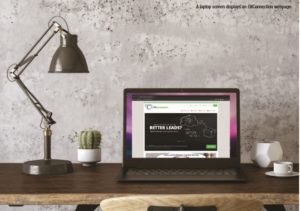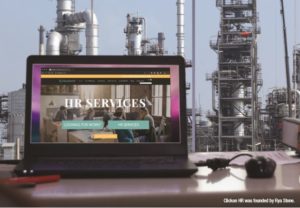A sign of the times: eCommerce reaches the oil patch.
As much as Amazon revolutionized the business-to-consumer market by offering an online marketplace that has largely left the brick-and-mortar business model crumbling in ruins, the oilfield marketplace has largely continued on in time-tested fashion, as follows:
A buyer looking for pumps or valves gets out a printed directory or phonebook, or goes through phone numbers in their smartphone contact list. He or she spends an hour or more making 3-5 calls asking for bids. The salespeople receiving the calls then examine their inventory and spend a couple of hours or more creating a bid, which they email to the prospective buyer—knowing that they have about a one-in-five chance of making the sale after all that work.
For Trunkline cofounder Amber Voithofer, PE, the idea for a pick-and-click alternative came about at a dinner meeting in November of 2018, where she met the person who would become Trunkline’s other cofounder—Joseph Chrasta. This was almost the classic “plan-drawn-on-a-dinner-napkin” cliché. But not quite.
“I was talking [to Joseph] about how it’s crazy that we cannot find anything oilfield online,” she said. “It’s crazy that we can’t find information or pricing or—anything. We really don’t have any resources other than calling the vendors.” And after making that call there can be a long wait for the vendor to send back the bid.
A third generation oilfield descendant, Voithofer had spent 15 years in the field and, more recently, as a consultant, where she had opportunity to make many of those exploratory calls and experience many of those long waits for responses.
Upon hearing Voithofer’s frustrations, Chrasta suggested another meeting to discuss ideas for an online marketplace that he had been exploring.
At their next meeting Chrasta revealed that he had built a prototype more as a directory than as a marketplace. Voithofer suggested that the directory information was only a start—that the website should look more like existing consumer-based websites, where prospective buyers can see actual products and pricing that would speed the buying process.
She wanted to see a search bar where a buyer could type in a product, and the website would populate a list of vendors who had that item, its pricing and availability, along with reviews and ratings. “At the end of the day,” she explained, “you want to know who had the product, first, and then you want to pick from who has that product available based on the company—if you’ve worked with them before, on their reviews, ratings, and availability.”
Voithofer sees the online reviews as a challenge at the start, but well worth the effort. She cited a case where a vendor working with a company in the Powder River Basin would be eliminated from the vendor list due to bad services—only to turn up working with another office of the same company a few days later in the Permian or elsewhere. An online review would help spread the news—good or bad—about a vendor.
In the startup phase Trunkline and other online marketplaces face a sort of chicken-or-the-egg situation of getting vendors versus buyers. For Voithofer, getting the vendors comes first.
“The first step on our side is, get the vendors interested, then get their products on, and then try to get them sales on those products. Then we’re going to try to get the customers to get reviews on them for their products and for the vendors.”
For the website development they started with a third party developer then decided it would be better to have Chrasta do the development himself.
They launched the current version of the website around the first of August.
Voithofer noted that she and Chrasta are a sort of yin and yang, whose diverse personalities make the division of labor easy. Chrasta is the technical guru who prefers to work in the background with programming and setup. Voithofer does what she calls the “front-facing” work of talking to vendors and buyers and the media.
Unlike Amazon, which was the actual vendor for books and other items and only later began to include other vendors directly, Trunkline’s mission is to simply connect vendors and buyers. They do directly sell some “swag” like socks and hats with Trunkline-related images—which have actually been very popular—but that’s the limit.
Oil Connection
For Luisa Sanchez, founder, owner, and CEO of OilConnection, the idea started in 2009 when she was a salesperson for the Odessa American. Her clients were oil and gas companies, whose marketplace was B2B. She took a short survey at the 2010 Permian Basin International Oil Show that helped guide her thinking. Using a web designer in Florida, she launched OilConnection in the first quarter of 2017.
While Trunkline is like an Amazon for the oil patch, OilConnection is more like Angel’s List, leaning more toward company connections that lead to sales. The website states, “OilConnection offers a safe environment, which allows Buyers to privately investigate Suppliers before they embark into any business interactions with them. We believe that Buyers should be able to have a Supplier’s pertinent information at their fingertips before they go to the next step.”
In the beginning, Sanchez decided, as did Voithofer, to bring vendors on first. “Vendors, for the most part, are happy to get registered.” She continued, “It’s a good place for them to be—you know their salespeople can’t be everywhere.” Some do resist the new platform but, “for the most part, they like registering their information. You see the little twinkle in their eyes when they look at their profile page and their logo’s there and all their information, all their safety credentials and things like that, they really do like it.”
Buyers, she notes, have been a little more challenging to round up. “I started out bringing on the smaller E&Ps and operators because I could talk to the decision-makers a little quicker and get a yes or a no,” she said.
The challenge with focusing on smaller companies, however, was that they’re not always in buying mode, and they may already have close relationships with preferred vendors. This pushed Sanchez into the next tier, medium size E&Ps, who are in buying mode most of the time for ongoing projects.
“They use us because they are bombarded all the time by vendors trying to get in the door.”
OilConnection buyers do like the background information, but Sanchez says their favorite thing is that “it can save them time versus emails and phone calls when they’re in a hurry and they can post what they’re looking for.”
With just over two years of history, Sanchez feels the site is starting to gain momentum. “Things have become a little static in the industry—I actually see that as an opportunity,” she said. “Number one, because the vendor is usually looking for someplace to make an easy connection with the buyer.” Number two, she said, buyers are looking to vet their vendor list to eliminate less qualified companies, “and they can do that on this profile without the vendor knowing what’s going on.”
That connectivity is part of Sanchez’s purpose for the website. “One of my passions behind this is the fact that our industry struggles to connect with each other. They’re either on their phones or trying to send a text or trying to shoot an email—and we see what’s going on with our traffic accidents and incidents. So if they had a quick and easy platform—and I believe that that’s what OilConnection provides—that they can connect with their vendors” it would save time and effort for all parties, she believes.
Currently the platform is focused on the Permian but Sanchez sees neighboring oil markets such as Oklahoma and Louisiana on the horizon.
Clickon HR
Using an online platform for buying and selling parts and equipment does seem like a logical option, but one Houston-based company has found a way to do some human resources work online.
In late 2018 Clickon HR’s founder, Rya Stone, saw that she needed an office in the Permian to be close to the majority of her firm’s clients. The journey to West Texas began about a year earlier.
After years working in private equity and also working with HR firms and as VP of HR for a chemical company, Stone had left the chemical company’s Houston office in 2017 to start a nonprofit. This was about the time Hurricane Harvey hit the coast and flooded the city for weeks. Concurrently, Stone had taken on some HR consulting projects. After the floodwaters receded in September/October of 2017 she created Clickon HR.
The name came about “when I was looking at what I was really doing when I had a vision for the company. I really wanted to get into HR technology down the road,” which could include several options including online HR compliance tools and being a sort of Tinder for jobs, where a candidate could swipe right or left on a job that was of interest. After discarding “TapOn HR,” “SwipeOn HR” and other options, the right name finally clicked.
Along with consulting work, Stone says, much documentation work can be done online. “I wanted to be sure that our clients could confidentially upload information online to a portal, and us keeping things as confidential as possible without printing anything” for things like HIPA compliance. “That’s why we wanted to make it an online platform.”
Currently the website’s clicking options include pricing information for the company’s three levels of service: HR Assistant, HR Generalist, and HR Executive. All are hours-based retainer services.
 Usually, however, any clicking is preceded by a telephone consultation where Stone or her staff answer questions and help determine the right service level for a new client. That consultation can be scheduled online.
Usually, however, any clicking is preceded by a telephone consultation where Stone or her staff answer questions and help determine the right service level for a new client. That consultation can be scheduled online.
In the Permian, Stone says, their business is split about 60-40 between HR advisory and recruiting. “The reason for that is the Permian market is driven by recruiting and the shortage of people. Once we find them the candidates, clients say, ‘Oh crap, I don’t have the bandwidth to onboard them,’” so Stone’s team gets the HR part of the process through hiring. This is in contrast to Houston, where advisory work accounts for 70-80 percent of the work.
After hiring and onboarding, ClickOn HR’s training can include information about Equal Opportunities Commission (EOC) rules, the Americans with Disabilities Act, sexual harassment, and other workplace issues. All this allows training and compliance to be done without hiring a fulltime staff.
The attentive reader will note that all three of these businesses started in earnest no earlier than 2017. This may be a sign of the fact that the Oil Patch has been slow to adopt the latest technology, but market forces are working to change that, especially since the last downturn. Many other online-based businesses have arisen during that time frame.
These are also all women-owned firms, which shows another trend, creating opportunities for more Vicki Hollubs, Ann Foxes, and other women in a historically male-dominated sector.
_______________________________________________________________________________________________________
By Paul Wiseman











